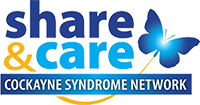Diagnosing
Cockayne syndrome is a rare neurodevelopmental disorder characterized by growth failure, abnormal brain development and degeneration, and some signs of premature aging.
Features of this disorder include a failure to gain weight and grow at the expected rate (failure to thrive), abnormally small head size (microcephaly), and impaired development and progressive degeneration of the nervous system. Some affected individuals have an extreme sensitivity to sunlight (photosensitivity), and even a small amount of sun exposure can cause a sunburn. However, CS patients do not develop skin cancer. Other possible signs and symptoms include hearing loss, cataracts, severe tooth decay, bone abnormalities, and changes in the brain that can be seen on brain scans.
Cockayne syndrome can be roughly divided into subtypes, which are distinguished by the severity and age of onset of symptoms. Classical, or type I, Cockayne syndrome is characterized by an onset of symptoms in early childhood (usually after age 1 year). Type II Cockayne syndrome has much more severe symptoms that are apparent at birth (congenital). Type II Cockayne syndrome is sometimes called cerebro-oculo-facio-skeletal (COFS) syndrome or Pena-Shokeir syndrome type II. Type III Cockayne syndrome has the mildest symptoms of the three types and appears later in childhood. The three subtypes are not completely distinct, and some patients have intermediate forms of the disease .
How common is Cockayne syndrome?
Cockayne syndrome occurs in about 2 per million newborns in the United States and Europe.
What genes are related to Cockayne syndrome?
Cockayne syndrome can result from mutations in either the ERCC6 gene (also known as the CSB gene) or the ERCC8 gene (also known as the CSA gene). These genes provide instructions for making proteins that are involved in repairing damaged DNA. DNA can be damaged by ultraviolet (UV) rays from the sun and by toxic chemicals, radiation, and unstable molecules called free radicals. Cells are usually able to fix DNA damage before it causes problems. However, in people with Cockayne syndrome, DNA damage is not repaired normally. As more abnormalities build up in DNA, cells malfunction and eventually die. The increased cell death likely contributes to the features of Cockayne syndrome, such as growth failure and premature aging. There is also a growing body of evidence indicating that in people with Cockayne syndrome, other proteins are not made in the required amounts or at the correct time in development, which can also contribute to abnormal brain development and degeneration. Read more about the ERCC6 and ERCC8 genes.
How do people inherit Cockayne syndrome?
This condition is inherited in an autosomal recessive pattern, which means both copies of the gene in each cell have mutations. The parents of an individual with an autosomal recessive condition each carry one copy of the mutated gene, but they typically do not show signs and symptoms of the condition.
CS Characteristics and Diagnosis
The following is a list of the most common characteristics noted in reported cases of CS. No child will necessarily have all the characteristics listed, and some of these findings are progressive.
- Social, jovial personalities
- Sunburns easily
- Progeria (premature aging)
- Shortened life span
- Microcephaly
- Neurodevelopment delay
- Short stature (height <5th percentile)
- Contractures
- Retinopathy and/or cataracts
- Hearing loss
- Poor circulation (cold hands and feet
- Low body temperature
- Mircopenis
- Feeding problems
- Sleeping with eyes open
- Tremors
- White matter abnormalities
- Basal ganglia calcifications
- Liver abnormalities; elevated liver enzymes
- Hypertension
- Severe itchiness
- Unsteady gait
- Spasticity
- Rounded back
- Deep set eyes, small slender straight nose
- Dental caries (cavities)


